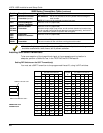
VISTA-10SE Installation and Setup Guide
5-4
For button transmitters (RF keys), such as the 5801, 5804, and 5804BD, you must assign a
unique zone number to each individual button used on the transmitter. Each button on the
transmitter also has a pre-designated loop or input number, which is automatically displayed
on the keypad.
Programming an RF House ID
Programming an RF House ID (01–31) in field
✱
24 is necessary only if you are using 5827 or
5827BD Wireless Keypads or 5804BD Transmitters. An RF House ID is not necessary for
other 5800 Series Transmitters, and the entry should be left at 00 (default) in those cases.
The 5827 reports low-battery status as zone 00.
Transmitter Supervision
Except for some transmitters that may be carried off-premises (5802, 5802CP, 5803, 5804,
5804BD, 5827, and 5827BD), each transmitter is supervised by a check-in signal that is sent
to the receiver at 70-90 minute intervals. If at least one check-in is not received from each
supervised transmitter within a 12-hour period, the “missing” transmitter number(s) and the
message CHECK is displayed.
In accordance with ULC standards, the RF supervision period for the VISTA-10SE is three hours
for fire zones (Zone Type 9) and 12 hours for all other zone types.
The supervision for a particular transmitter in the system that may also be carried off the
premises (5801, 5802MN) may be turned off by enrolling it as a “UR” (unsupervised RF) type,
as described later.
5800 Series transmitters have built-in tamper protection and annunciate as a Check
condition if covers are removed.
Transmitter Input Types
All of the transmitters described have one or more unique, factory-assigned input (loop) ID
codes. Each of the inputs requires its own programming zone (for example: a 5804's four
inputs require four programming zones). Refer to the ZONE PROGRAMMING section.
Transmitters can be enrolled as one of the following types:
Type Description
RF
(Supervised RF)
Sends periodic check-in signals, as well as fault, restore, and low-
battery signals. The transmitter must remain within the receiver's
range.
UR
(Unsupervised RF)
Sends all the signals that the “RF” type does, but the control does
not supervise the check-in signals. The transmitter may therefore be
carried off-premises.
BR
(Unsupervised Button RF)
Sends only fault signals. It will not send a low-battery signal until it is
activated. The transmitter may be carried off-premises.
Transmitter Battery Life
Do not install batteries in wireless transmitters until you are ready to enroll the transmitters
during system programming. After enrolling, batteries need not be removed.
Batteries in the wireless transmitters may last from 4 to 7 years, depending on the
environment, usage, and the specific wireless device being used. Factors such as humidity,
extreme temperatures, as well as large temperature variations may all reduce the actual
battery life in a given installation.


















